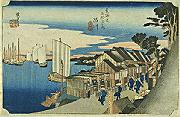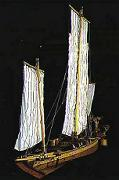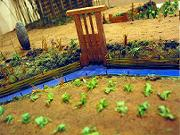Modern Shinagawa
Tokugawa Ieyasu entered Edo after the Hojo clan was overthrown in 1590 (18th year of the Tensho Era). From this time, the Tokugawa clan ruled Shinagawa until the end of the Edo Era. Shinagawa-shuku flourished as the first post station on the Tokaido Road. Farming villages in Shinagawa brought vegetables to Edo and sold them. Also, fishing villages on the coast cultivated seaweed and caught seafood in Edo Bay.
Shinagawa-shuku on the Tokaido
Shinagawa-shuku was the first post station on the Tokaido Road from Edo. Many people came and went there, such as travelers, Daimyo (Japanese feudal lords) pilgrims bound for Ise Shrine, and so on. Shinagawa-shuku was the gate to Edo. It was here that people were welcome into Edo and where they were bid farewell. It was where Daimyo mustered their retinue and fixed their appearance before entering its gates.
Many people visited the nearby playgrounds of Edo’s outskirts to fish for clams and view cherry blossoms at Gotenyama, or take in fall foliage at Kaian-ji temple. There was an entertainment town with many licensed quarters. To differentiate between northern Yoshiwara, many called Shinagawa-shuku the “South.”

Fifty-three Stations of the Tokaido Road: Sunrise at Shinagawa
Utagawa Hiroshige I c.1833 (4th year of the Tenpo Era)
Farming
Shinagawa in the modern era was mostly farming villages. In the early Edo Era, aside from low-lying areas near Meguro River and Tachiai River, there wasn’t much arable land because of lack of access to water. Irrigation ditches passed through Shinagawa and Mita, and fertile land began to increase. In this era arable land spread all over the country as both irrigation systems were opened.
After the 18th century, carrots, bamboo shoots, and leeks among other commercial crops were grown in Shinagawa.
Model of Shinagawa irrigation system
This model shows “Jizo no Tsuji” (a crossroads with a Buddhist statue). It was in present-day Koyama Ni-chome.

Tools for gathering bamboo shoots
Chisel (right) and Spatula (left)
The spatula was used for digging soil, and the chisel was used for separating the bamboo shoots from the root.
Fishing
Fisheries were established in Edo Bay after the Edo Era. It was said that fishermen with cutting-edge technology moved to the area from Kamigata near Kyoto and Osaka. These fishermen joined forces with local fishermen and formed two fishing villages called Shinagawa-ura and Ohayashi-ura in the Shinagawa area. These two villages came to be known as “Osai Hachikaura,” and supplied fish to Edo Castle.
Also in the 18th century, seaweed was cultivated in Shinagawa and delivered to wholesalers in Asakusa. Shinagawa seaweed, under the Asakusa brand, became known across the country as a “specialty of Edo.” The sight of hibi, or wooden branches that were placed upright in the ocean for the purposes of growing seaweed, became a famous sight on the coast of Shinagawa. Views of hibi were featured in Ukiyoe, travel diaries, and so on.

Model of Ketabune
Shinagawa at the end of Edo period
In June, 1853(6th year of Kaei Era), Perry of the United States arrived in Edo Bay. As a result, the Tokugawa shogunate constructed Shinagawa Odaiba which is Western-style marine batteries as a base to defense of Edo Bay. Also, Shinagawa was the arrival and departure port for Japanese embassies who were dispatched by Tokugawa Shogunate after Conclusion of the Treaty of Amity and Commerce between Japan and the United States in 1858(the 5th year of Ansei).
Thereafter Shinagawa became the location for the upheaval at the end of the Edo period because the fire attack of the legation of Britain located in Shinagawa Gotenyama and the destructive riot in Shinagawa-shukun broke out.。



